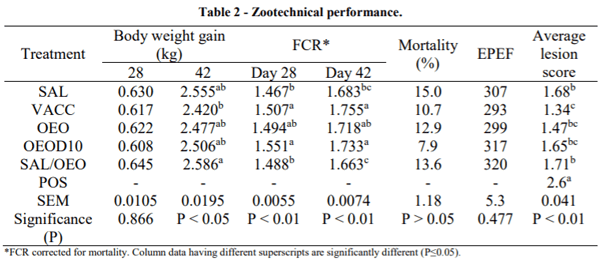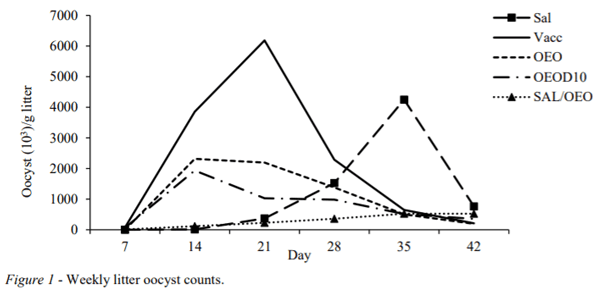Development of Coccidial Vaccinal Immunity is Not Impaired by Feeding Oregano Essential Oil
Coccidial vaccination is an alternative to medication programmes, although vaccination can lead to impaired performance. The objective of this study was to determine the effect of coadministration of an oregano essential oil (OEO) product in feed and an attenuated Eimeria vaccine on performance and immunity of vaccinated birds. A total of 1,750 Cobb broilers was randomly allocated to 5 treatment groups (7 replicates/treatment 50 birds/replicate): CON – salinomycin (66 g/t); VACC – HatchPac Cocci III (Merial, USA) single dose Day 0; OEO – OEO (300 g/t); OEOD10 - OEO (300 g/t) from Day 10; SAL/OEO – salinomycin (66 g/t), OEO (150 g/t). Birds in OEO, OEOD10 and SAL/OEO were vaccinated on Day 0 with the anticoccidial vaccine. With the exception of VACC and OEOD10, in-feed treatments were fed the entire study, 0-42 days. Birds were reared in floor pens on clean litter. Litter samples were collected weekly for oocyst enumeration. On Day 21, 5 birds/pen were moved to cages (35 birds/treatment, 7 replicates) and challenged orally with a mixed Eimeria infection. Coccidiafree birds were used as a positive control (POS) (5 birds/cage, 7 replicates). Birds were fed an untreated ration for the challenge phase. On Day 27 birds were euthanised, weight recorded and coccidial lesion scored (LS). Coccidia were detected in the litter of SAL from 10 days indicating contamination. Body weight gain in VACC was significantly lower than SAL/OEO; all other treatments did not differ significantly. Feed conversion ratio was significantly higher in both VACC and OEOD10 versus SAL and SAL/OEO while VACC, OEO and OEOD10 did not differ significantly. Lesion scores were significantly lower in all treatments versus POS while LS in SAL and SAL/OEO was significantly higher than VACC. Oocyst enumeration profile demonstrated a peak in VACC on Day 21 that was absent in all other treatments. In conclusion, the inclusion of OEO in poultry feed from Day 0 or Day 10, either alone or in combination with salinomycin, and fed to birds vaccinated with an attenuated Eimeria vaccine on Day 0 had no adverse effect on the development of coccidial immunity. The combination of OEO and salinomycin significantly lowered Day 0-42 FCR versus birds receiving vaccine or OEO alone. The use of OEO in combination with an Eimeria vaccine or an ionophore offers another potential tool in the management of coccidiosis.



Bozkurt M, Ege G, Aysul N, Aksit H, Tüzün AE, Küçükyilmaz K, Borum AE, Uygun M, Aksit D, Aypak S, Simsek E, Seyrek K, Koçer B, Bintas E & Orojpour A (2016) Poultry Science 95: 1858-1868.
Chapman HD & Jeffers TK (2014) International Journal for Parasitology: Drugs and Drug Resistance 4: 214-217.
Giannenas I, Tzora A, Sarakatsianos I, Karamoutsios A, Skoufos S, Papaioannou N, Anastasiou I & Skoufos I (2016) Annals of Animal Science 16: 779-796.
Idris M, Abbas RZ, Masood S, Rehman T, Farooq U, Babar W, Hussain R, Raza A & Riaz U (2017) World's Poultry Science Journal 73: 89-104.
Johnson J & Reid WM (1970) Experimental parasitology 28: 30-36.
Küçükyilmaz K, Bozkurt M, Selek N, Güven E, Eren H, Atasever A, Bintas E, Çatli AU & Çinar M (2012) Italian Journal of Animal Science 11: e1.
Waldenstedt L (2013) Acta Agriculturae Scandinavica, Section A – Animal Science 53: 101- 109.


United States










